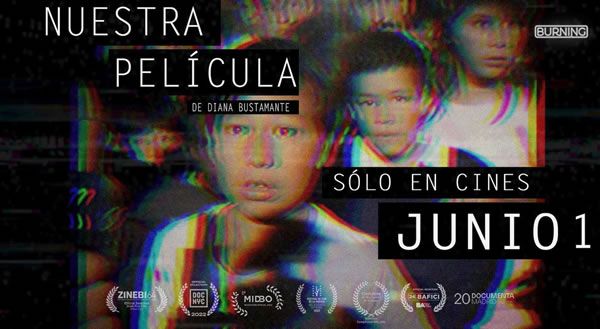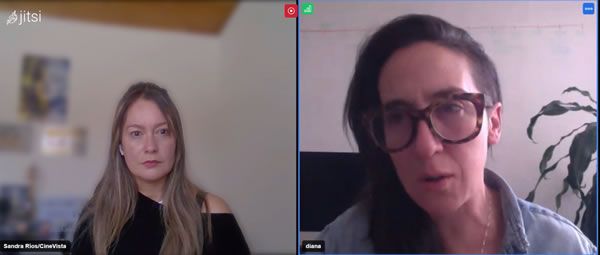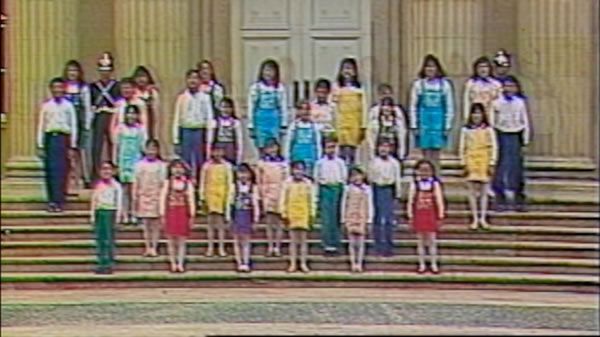06/05/2023
Our Movie: Unveiling the Power and Impact of Violent Images in Colombian Society
By Sandra M Ríos U
Twitter: @sandritamrios
"This piece of darkness that inhabits us has a lot to do with the society in which we grew up."
Intervening the archival footage to tell a story full of images that account for our violent past, but above all, how it has been portrayed, leaving a mark on a generation that consumed almost everything produced on the small screen with fascination, is the first feature film, as an essay, directed by renowned producer Diana Bustamante.
The result is a film (read review) that questions the treatment of those images, the absence of context, the repetition, and the trivialization of violence.
In this conversation, Diana shares about the arduous work of collecting and rescuing those images, the purpose of her film, the conversation it proposes in the present, the personal toll it took on her to the point of getting sick, and the connection between the title and Luis Ospina.
This is a film entirely made with news footage from the 80s, extending to the 90s, from Colombian television. The images consist of what was broadcasted on television and some raw footage from the news before it aired, like what was discarded and what was shown. It's a film in which I wanted to question the meaning of these violently produced images, the violent events they depict, and the narrative and impact they had on multiple generations, an impact that we continue to experience today. I wanted to explore certain specific aspects of these images, such as the repetitions and the trivialization of violence through the spectacularization of that same violence in the media.

I believe that in films, there isn't a single reason that leads to making decisions. I strongly believe that there are energies, if you want to call them that, certain things that happen to shape things. I didn't know what title to give to the film. Luis passed away without watching any of it, but the last few times I saw Luis while he was still alive, we were both competing for the Idartes grant, him with "Mudos Testigos" and me with this film. Luis was not feeling well in those days, and I had fallen, using a walker, so we were both unwell, both dressed in black, it was cold, and we were both making films using archival material, and we made jokes about it. Later, we saw each other again, Luis was feeling better, when he accompanied us during the filming of "Memoria," and that was indeed the last time I saw him.
When I returned from filming "Memoria," I had many dreams about Luis, and in those dreams, there was always a theme related to hair. Luis would always say things about hair. At that time, I was undergoing therapy, and a psychiatrist told me that dreams sometimes have layers, meaning that hair is related to ideas. After that, I decided to fully engage in the film, motivated by Luis's presence in my dreams. But that wasn't the reason for the title; the reason is that I was already finishing editing it with Sebastián Hernández, and I said to him, "Sebas, what are we going to do with our movie?" We both had a moment of realization and said, "That's the name." The coincidence was perfect, just like the film itself; it's about us. The name seemed very powerful to me because it's not about me, which was something I constantly tried to avoid when I thought about it. The name came by chance, and the one you mentioned is one of the films by Luis that I appreciate the most.
Juana Suárez made a beautiful interpretation, saying that Luis's film is about a decomposing body, about a dying body, which is that of (Lorenzo) Jaramillo, a painter. "Our Movie," by Diana Bustamante, is a film about a decomposing body, which is that of a society also marked by death. It makes me very happy to have Luis in my film as the teacher that I believe he was for all of us.
Well, you know, just like with the name, I think we invoke things from the beginning. When I was studying film, I never anticipated becoming a producer. I started doing it, and I think I've tried to approach it honestly. I have dedicated my whole life to cinema, to making it, thinking about it, working for it. But with the first film I made, what happened was that it had impossible durations. It's a short film that's too long and a feature film that's too short; it's about 48 minutes (laughs). It's a film about memory, about the memory of an artist I really like named Jacqueline Noah, who is a composer and the precursor of electroacoustic music in Colombia. It was my thesis project, but I think it has a lot to do with "Our Movie" because I experimented with many things in it. Memory has always been my subject, and I really liked what happened there. So, let's say it is my first feature film, within the correct standard, although I have never been a person within the standard (laughs). I started making it around 2016, which is also quite a few years ago, and I also made other films and did other things in the meantime.
The first thing was to think about the images, my interest in delving into them. So, the film almost started as a more formalist exercise. Sometimes I say that those images won me over because of the human resonance they had in me. As a woman, the material won me over, but I'm happy that it did because I feel like I have less trauma now. In fact, I know more about myself now after making this film and reflecting on my relationship with death. This darkness that resides within us is closely linked to the society we grew up in. The film ended up being much more emotional and political than I had initially expected.

I initially wanted to make a much more abstract film, but it was impossible. For example, I always wanted the image of children singing the national anthem, but I wanted it because they seemed horrifying to me, like the beginning of a horror movie. But as I delved into the material, I understood that what I was making was actually a documentary of horror, not terror, but horror. I realized that I was part of those children and that I had a trauma, and I couldn't talk about the film. When I pitched the film, I couldn't stop crying. People looked at me, thinking, perhaps, that I was a victim, and I am, but not directly. We should all feel that pain because it's a pain that continues to affect us, and it's very significant. It was impossible for the film not to be as emotional as it is.
It seemed like a great start because it opened and closed the programming, and also because the film makes various allusions to national symbols and deconstructs those symbols. So, I was interested in starting from there because we were talking about a society, and for me, the national anthem represents the establishment, a State that has allowed many things to happen.
The investigation of the material started with Caracol Televisión because I had worked there, and I had the opportunity to meet Marta Linares Trejo, who organized the Caracol Televisión archive. By the way, it is the best news archive in Colombia and, I believe, one of the best in the continent because they invested in digitization and restoration. They have the archive of what was the National News, the 7 o'clock News, and other regional news programs. Yeily and Juan Sebastián were responsible for the bibliographic research because there was a point where I needed a lot of information from the library, newspapers, how all the media recorded it. Both of them not only did extensive research work but also recovery work.
In total, we had more than 600 hours of material, which is crazy, and, just like in the film, there are repetitions of materials that you have to watch. It was hours and hours of reviewing images and finding things like the one with the mayor of Urabá speaking, which I found by chance among images of a beauty pageant. Much of that material is part of Señal Memoria, but it's not publicly accessible. I find that very sad because I believe that a country's memory should be accessible to everyone.
Once I had all the material, I went to a country house, and I got sick. I felt dizzy because of the sadness the material generated in me. The editing process was a very free exercise, closely related to what the material was telling me. I organized the sequences based on concepts, which were always repetition, accumulation, and emptiness. Repetition generates accumulation, and accumulation results in a void of meaning. That was what I wanted conceptually, and that's how the film is structured. However, from the beginning, I knew that I didn't want to make a film about the history of Colombia, a film from a historiographic perspective. Later, with the wise hands of Sebastián Hernández, we worked on refining many ideas, contributing some things, and also making the discourse flow better because my initial film was less accessible, its interpretation was more complex.
Honestly, everything did. One of the first things I thought of for this film was the assassination of Luis Carlos Galán because I remember myself as a little girl watching that. I always thought a lot about massacres, like the one in Segovia, and I always had a memory of being shown the bodies and the blood, which was always there. If you detach yourself from what the image represents, it's beautiful. The blood glistens, it's like fiction, there's an aesthetic behind it, just like fictional narratives have, which is cosmetic and spectacular.
Everything impressed me, but I remember the scene with little Rodrigo Lara, the boy who lights a cigarette for his mother and cries and cries. It's an image that I find outrageous. I think, in contrast, that cameraman is filming something else. If you look closely, he is capturing the pain of that child. That same scene has many cameras because the assassination of Rodrigo Lara Bonilla was very important, and everyone was focused on the arrival of the president and the politicians, but no one looks at the child. I was struck by that image because it was devastating.

You read it perfectly, although everything in life is political, but clearly, the film proposes a conversation. For me, this is a collective reflection. This topic has many echoes regarding images, precisely in relation to today, what massification and the spectacularization of certain types of images produce. Do we need to inform? Yes, of course, we need to inform, but in what way?
I always envisioned the film without voices as a formal challenge. I wanted to think and make an effort for the film to speak for itself without needing footnotes, without obviousness. It didn't have much voiceover, and I didn't record that voiceover in a studio or anything. At some point, I realized that, of course, I was present in the film, and it was important to let the audience know from where they were watching this film, not from the perspective of a 40-year-old director, but from the perspective of the little girl watching those images. At first, I struggled with this idea, but later on, I made peace with it.
David, my producer, came into the process quite late. I already had a rough cut, and I am infinitely grateful that he is with me because, at first, it was very difficult. I spent a long time working on it alone. It was a lot of work. Organizing myself is very difficult because I'm always thinking about others. I am absolutely convinced of the necessity of a producer.
David and I are working on another project together, with him as my producer. It's another film that incorporates archival footage, but a completely different archive. I wanted to do something luminous, so it's an archive from the San Antonio de los Baños School, showing the first-year shorts made by the students throughout history. But let's say it's not necessarily a film about the school, but about many other things. I'm also working on a short film that will be an installation at León de Greiff, at the National University.
This interview was conducted on Monday, May 29th.
<< Go to Spanish version
